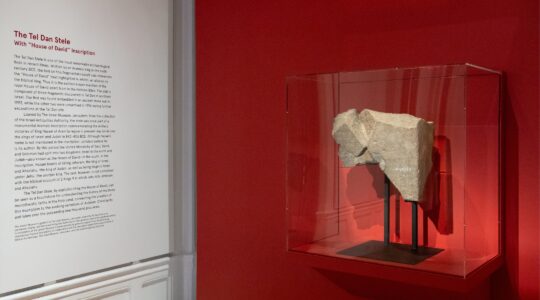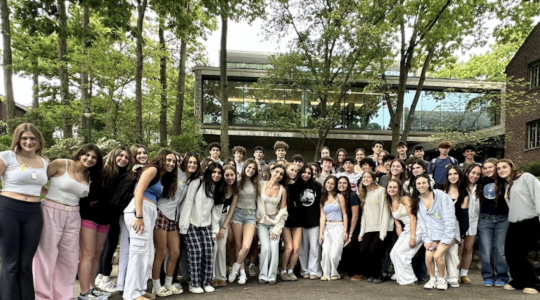Warwick, N.Y. — The sun was setting at the Reform movement’s teen leadership camp in this picturesque upstate town, and in the dying light of a sweet summer day it was time for the evening prayer service. In the lakeside pavilion that serves as Kutz Camp’s synagogue, the visiting musician who led the evening service on the Fourth of July, a Wednesday, set the prayers to an easy-listening jazz sound. It was a musical style, played on an electric keyboard, that almost none of the campers connected with, many said later. But some took their displeasure a step further, doing something unprecedented that night at Kutz that speaks volumes about a generation of Reform teens that is staking a new claim to Jewish ritual and tradition and posing a challenge for movement leaders.
As the musician played a jazzy version of the Barchu, a couple of campers got up and walked out. Over the next several minutes, other pairs of high school-age campers, one after another, got up and quietly left. It took awhile for the adults in the room to realize what was happening, but some 40 campers in all, about a quarter of those in attendance, spontaneously got up and left the service. The service was too untraditional, they later said, offensively so. Turns out, it was their own spiritual Independence Day.
Once out of the pavilion, clusters of teens agreed to find different spaces so that they could continue their prayers the way they wanted to. Some ended up forming a minyan in a bathroom.
“When the prayers were very nontraditional, they felt botched; the music was so distracting,” said Sarah Wolfson, a 16-year-old from Calabasas, Calif., who is social action vice president of her temple youth group. “It seemed so disrespectful. I’ve become quite attached to saying the prayers the way I was bat mitzvahed with. It’s something I find really powerful,” she continued.
Wolfson was one of the campers who went to a girls’ bathroom to pray. “We were all able to create that connection together in our gathering. It was very moving and empowering.”
These teens are part of what appears to be a growing number of young adults in the denomination more interested in conventional prayer and traditional Jewish observances than their parents are. Kutz Camp, which runs sessions from late June through mid-August, attracts the most-committed Reform teens from around the country and so, while what happens there may not be typical of what’s going on everywhere, it is a seeding ground for new leaders and a place where developing trends are evident.
In addition to demanding more traditional prayer, a small but growing number of campers and young faculty there are wearing yarmulkes or tzitzit, even tefillin along with prayer shawls. One of this year’s campers had shuckling — the rhythmic prayer-rocking usually done by fervently Orthodox men — perfected. For the first time, song leaders taught the chasidic songs of Rabbi Shlomo Carlebach alongside more modern Reform tunes.
There are even “rumblings” of interest in making the camp, which is now kosher-style, really kosher, said Kutz Director Rabbi Eve Rudin. “We first started seeing kids lay tefillin two or three years ago. Certainly we saw it last summer. It’s a handful of kids. Tzitzit are more widespread; quite a few kids are wearing them.” It’s an ironic shift for Kutz, which has long been a site of creative experimentation, like the jazz service, in Reform worship.
It also seems to reflect a growing generation gap, with current leaders of the movement’s institutions not always fully ready to embrace the changes that its youngest constituents are calling for. Several young faculty members at Kutz this summer (where I taught writing during the first session) wanted to gather to sing the traditional Friday evening Psalms at the edge of the lake before camp-wide Kabbalat Shabbat services. Initially, said one faculty member who asked not to be named, they were given tacit permission as long as they didn’t invite camper participation. But then they were told they could not, since singing the Psalms — even though they’re contained in the Reform prayer book — isn’t a conventional Reform practice.For Rabbi Rudin, the issue was about faculty members separating themselves from the rest of the community in order to do something which “would be seen as ‘more religious,’ or ‘better,’ ” she said.
“We as a faculty are here to enable the experience for the kids, so if the kids see that the faculty are not pleased with the worship, what are they going to think about their own Jewish practice? I want every camper to feel proud of the Jewish choices they are making and not to feel that ‘more is better’ or ‘more traditional is better.’ ”Top Reform leaders are equally concerned that those more inclined to classical Reform Judaism, which is less focused on ritual observance, not feel alienated by those interested in tradition. Rabbi Eric Yoffie, president of the Union for Reform Judaism, heard from many campers about the “botched” jazz service when he came to Kutz for a visit in mid-July. “They were so afraid of offending these kids [the more religiously inclined] that they were too intimidated to proceed in their desire to bring creative approaches to prayer, something we normally do in virtually any youth setting,” Rabbi Yoffie told The Jewish Week.
Rabbi David Ellenson, president of the movement’s seminary arm, Hebrew Union College-Jewish Institute of Religion, said in an interview that “the Reform movement has to be tolerant and embrace classical Reform Jews for whom this embrace of tradition is not something they celebrate. I would hope it would remain sufficiently pluralistic to include both camps.”
Some Kutz teens also viewed unity as the priority.
Support the New York Jewish Week
Our nonprofit newsroom depends on readers like you. Make a donation now to support independent Jewish journalism in New York.
Grace Klein wrote in the camp newspaper after the jazz service that “as disturbed as I was throughout the service, I as well as everyone else who stayed, chose to place the unity of Kutznikim over personal satisfaction. The choice also had to do with respect” for the musician leading the service.
“The fact is that many of us prefer the traditional aspects of Judaism, particularly in worship, more than previous Reform generations did,” she wrote. But “If anything, the schmaltzy, keyboard extravaganza was an experiment … the way to lead the movement towards tradition is not to balk at our predecessors’ choices but to basically keep on doing what we’re doing.”
While the tensions raised by this developing issue may have been more visible at Kutz than in other Reform-affiliated institutions, it is not the only place the interest in traditional observance is being seen.
Many young Reform rabbis are reversing choices made by their older colleagues, some of whom proudly eat shrimp and bacon.
David Singer, 24, is part of this new wave. Entering his fourth year of rabbinical school at HUC-JIR in the Village, he always wears a kipa and tzitzit, keeps kosher and doesn’t ride or use money on Shabbat.
But he does it all from a purely Reform perspective, which emphasizes personal autonomy in religious practice, a principle he regards as among the highest of values, he said in an interview a few weeks ago. The spreading interest in traditional observance is creating “a tug of war between pluralism and uniformity” for the movement, said Singer, who was on the Kutz faculty.
“Maybe it’s a fear that ‘God forbid we become more like the Orthodox.’ It’s not about being Orthodox, but the exact opposite because we want to do it in a plurality of ways and are choosing to do it, which is not what Orthodoxy is about. It’s seen as a threat, but it shouldn’t be.”
Singer grew up in the Reform movement, in its summer camps and attending a Reform day school in his home city of San Diego, and now lives in Brooklyn.
“I’m definitely one of the more observant people in my [rabbinical school] class,” Singer said. But “I know that as a class we all struggle to find our place within the Reform movement. “Do any of us pray in Reform synagogues in New York City aside from small minyanim at Beth Elohim?” the Park Slope Reform synagogue where he works as rabbinic intern. “No. You’re more likely to find us at the independent minyanim” that in recent years have sprouted up around New York City, where the approach to prayer tends to be at once creative and traditional.
“We’re looking for things outside the box in which our generation feels comfortable experimenting and expressing our Judaism in ways that haven’t always fit into the established norms of Reform Judaism. At times it is seen as an affront to people who aren’t always ready for it,” Singer said.
So can these conflicting approaches to Jewish worship and observance be reconciled within the Reform movement? It’s a real-world challenge, said Rabbi Yoffie, who in 1999 called for “a Reform revolution” in worship, with more emphasis on lively prayer and text study. “There isn’t a shul in the world that doesn’t struggle to create a worship experience meaningful to everybody.”
Taking on Jewish observance should be embraced, said Rabbi Yoffie — to a point. “No aspect of the tradition should be foreign to us. We should be prepared to explore everything. Even things that would have been unthinkable to parents and grandparents,” said Rabbi Yoffie. “Some people may want to go and become either Conservative or Orthodox. So be it.” There are limits to what the Reform movement can encompass, he said. “We’re a mitzvah-oriented tradition, not halacha-oriented,” he said, referring to Jewish law. “If you take it all upon yourself as an obligation rather than as a choice, you’ve reached the point at which you’re no longer a Reform Jew.” Back at Kutz, as third-session campers arrived, many to participate in community service programs as part of the camp’s “Mitzvah Corps,” Rabbi Rudin reflected on the tensions playing out between those interested in greater observance and those who are not.
Support the New York Jewish Week
Our nonprofit newsroom depends on readers like you. Make a donation now to support independent Jewish journalism in New York.
“We do want there to be experimentation, and I do think there’s a place here for someone who keeps strictly kosher and to wear tefillin. This is supposed to be a very pluralistic place. But in the end, even though the Reform movement is about being pluralistic, there is a range” of accepted behaviors, she said.
“This is about the Reform movement coming to terms with the fact that there are boundaries, and what those boundaries may be.”
The New York Jewish Week brings you the stories behind the headlines, keeping you connected to Jewish life in New York. Help sustain the reporting you trust by donating today.




